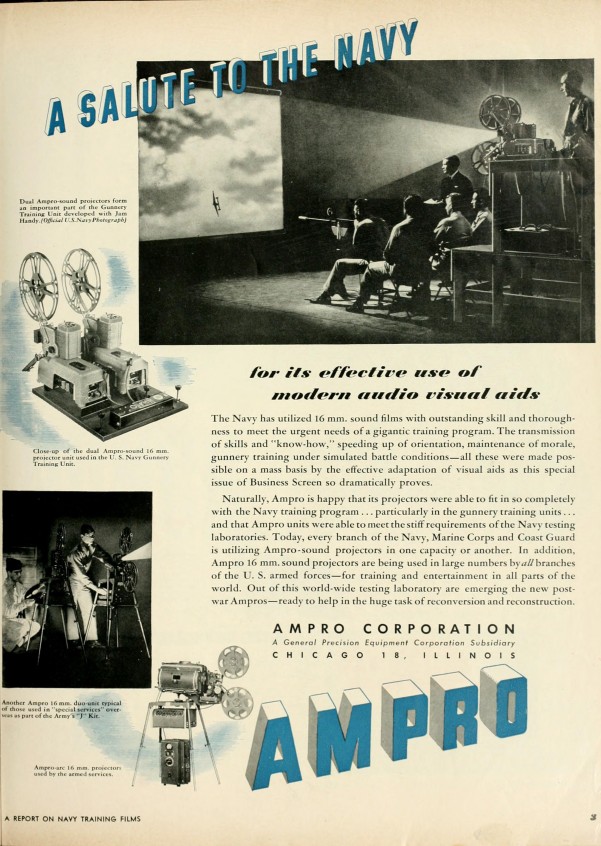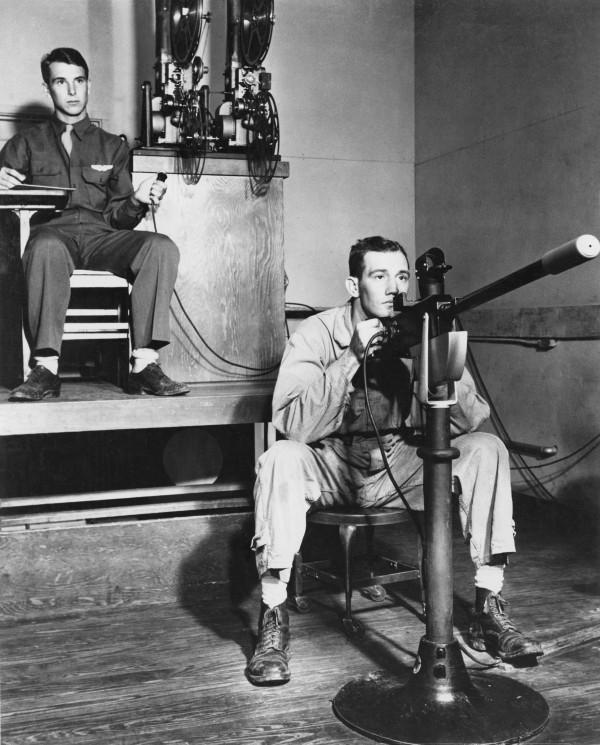A 16mm dual projector format, used for military training by the United States Navy, Marines and Army Air Corps during World War II.
Film Explorer

The Jam Handy Aerial Gunnery Trainer used two 16mm films projected simultaneously. The primary film (seen here) displayed model enemy aircraft swooping down into view. A secondary film, projected on top of this, overlaid a target to help the trainee gunner improve his aim and timing. The soundtrack on the primary film consisted of the sounds of an airplane engine.
Courtesy of Jonathan Boschen.
Identification
10.26mm × 7.49mm (0.404 in x 0.295 in).
B/W
Standard 16mm Eastman Kodak edge markings.
2. 16mm Ampro sound projectors projected two overlaid images onto one 12 ft x 12 ft (3.66m x 3.66m) Radiant screen.
Aerial Gunnery Training Film
Variable-density optical sound. The film soundtrack consisted of an airplane engine sound effect, heard throughout the entire film.
Unknown
B/W
Unknown
History
During World War II, the Jam Handy Organization – one of America’s leading producers of industrial, advertising and training films – was contracted by the US Navy’s Bureau of Aeronautics (Special Devices Division) to produce a 16mm Aerial Gunnery Training device that could be used to help train servicemen in the manual targeting of enemy aircraft. The Jam Handy Trainer was developed as a smaller and simpler alternative to the elaborate and effective Waller Flexible Gunnery Trainer (which employed five synchronized 35mm projectors and a domed screen). As indicated by several declassified reports, the Jam Handy Trainer was very successful and regarded as an extremely useful tool by the military.
The Jam Handy Trainer was a smaller and simpler version of the Waller Flexible Gunnery Trainer, and was originally made for the Navy to be used on ships where space was at a premium. The Trainer utilized 16mm safety film, allowing it to be used in a greater range of locations – unlike the Waller Flexible Gunnery Trainer, where the use of potentially combustible 35mm nitrate film restricted use at sea. Over time, as the devices were found to be effective, the Army began ordering them, as well. (When the Army acquired the device, it was renamed the E-14 Trainer.) The Trainer was developed by Jam Handy’s chief engineer J. A. Pool and each device was initially priced at $2,065.50 (equivalent to around $40,000 in 2025). Throughout 1942, 52 trainers were produced for the United States Navy and Army – by the end of World War II, in the summer of 1945, a total of 593 units had been reportedly made, 420 of which were procured by the “Flexible Gunnery Schools” (“Flexible Gunnery Training In the AAF”, 1945). Between April 1942 and January 1944, over 1,000 Special Devices Division officers and gunnery trainers visited the Jam Handy Organization, in Detroit, to participate in their “Train the Trainer” program. Originally the trainer consisted of two Ampro 16mm projectors, a 12 ft x 12 ft (3.66m x 3.66m) screen, and a mock .50-caliber (0.5 in/12.7mm) machine gun. As the war progressed, the Jam Handy Trainer was modified to include a mock gun turret and also a device referred to as “3A-20”, which could mechanically monitor and assess the trainees’ shooting accuracy.
Overall, despite some flaws with scoring and tracking results, the Jam Handy Trainer was regarded as very effective. A 1947 report for the Army Air forces, by Nicholas Hobbs, “Psychological Research on Flexible Gunnery Training”, stated that the devices had proved to be the most “versatile” of all of the different film trainers on offer. The report highlighted that due to their simplicity, they could be easily adapted to meet the specific needs of individual instructors and trainees. While the devices were not able to simulate a primitive virtual reality of flight like the Waller Flexible Gunnery Trainer, they were still able to assist in the training of targeting and striking the moving target of enemy planes.
Following World War II, the Jam Handy Organization continued to produce aerial gunnery trainers for the military. Unfortunately, it is unknown how the devices evolved after the end of the war up to the early 1950s, when they are believed to have been phased out. Around this time Jam Handy had developed a more complex gunnery trainer which put to use the company’s “Hemispherical” 142-degree widescreen lens.

Opening title to an Aerial Gunnery Training film.
Courtesy of Jonathan Boschen.

A trade ad by Ampro Corporation which shows Ampro’s dual projector system in use on the Jam Handy Trainer.
Ampro Corporation (1945). “A Salute to the Navy”, Business Screen, 6:5 (“A Report on Navy Training Films”): p. 3.

Metal plate, originally mounted on either Jam Handy Aerial Gunnery Trainer equipment, or transportation cases.
Courtesy of Brian Oakes.
Technology
When the trainer was first developed in 1942, it utilized two Ampro 16mm sound projectors, a 12 ft x 12 ft (3.66m x 3.66m) screen, and a mock .50-caliber (0.5 in/12.7mm) machine gun – the projector system was placed 12 ft (3.66m) from the screen. The student sat between the projectors and the screen and would shoot "light bursts” with the mock gun at enemy aircraft that were projected onto the screen by one of the 16mm projectors.
The enemy aircraft 16mm film opened with a title card: “Aerial Gunnery Training Film – Prepared for the US Army Air Force, U.S. Navy Air Force – by the Jam Handy Organization”. This was followed by a title card indicating the type of aircraft the trainee was supposedly flying in, as well as the speed that they are traveling at. The films then featured brief sequences of single enemy planes attacking them. The sequences were composed of realistic model airplanes of enemy aircraft, flying against a painted backdrop. These planes were moved in a way that accurately simulated the movement of the particular aircraft. Each sequence identified the type of enemy aircraft attacking them and provided information on the wingspan and length of fuselage. Throughout the film, the constant sound of airplane engine noise was heard. Before the opening title card, the film featured a special leader to synchronize the film with a second “polarized light” film. The maximum length of the films was 1,600 ft (487.68m).
As the enemy aircraft film ran, a second 16mm film was synchronized to it, which projected a circle (or target shape) onto the screen using polarized light. This polarized target instructed the student where, and when, to shoot. The trainee would aim and shoot his mock gun at the screen – as the trainee pulled the trigger, the gun projected "light bursts” onto the screen, revealing the student’s aim and timing to the instructor. Polarizing the light to the “target film” allowed two training modes: one, where both instructor and trainee could see both primary and secondary films superimposed; and, a second, where the trainee would wear a pair of polarized glasses, preventing them from seeing the polarized “target”. In the latter mode, the instructor was able to see how accurately the student aimed, without the assistance of a visible training target.
As the war progressed, modifications were made to the Jam Handy Trainer. A mock gun turret was developed, which could mimic the motions of a Boeing B-29 Superfortress bomber turret and was operated by foot pedals. One of the more interesting later iterations was a mechanical scoring device, using infrared technology, referred to as the “3A-20”. A 2-in (50.8mm) spot of infrared light was projected onto the screen, in the same position as the polarized “target” – the mock machine guns contained a photoelectric cell, sensitive in the infrared region of the spectrum, which could detect infrared light reflected back from the screen. If, when the trainee shot his gun at the screen, the photoelectric cell detected reflected infrared light emanating from the projected infrared “target”, the 3A-20 device was able to detect and register when the trainee had hit their targets. It also allowed the Jam Handy Trainer to use “gongs” – machine-gun sounds, and other sound effects, to signal “hits” and “misfires”. The infrared technology also allowed multiple students to use the Jam Handy Trainer at once. While ingenious, the technology had its flaws, and the device was apparently redeveloped and modified on several occasions. Seemingly, three different variations of the 3A-20 were designed during the war – the 3A-20A, 3A-20B and 3A-20C. The model referred to as the 3A-20C is cited as being the most reliable of the three. Due to its flaws, many instructors chose not to use the automatic scoring devices, sticking with the original ‘light burst’ manual-scoring method.

The Jam Handy Trainer in use. One projector projected the image of the airplane in flight onto the screen, while the second projector projected a target circle using polarized light. Note the polarized glasses on the trainee, which eliminated the circle from view.
“Gunnery Trainer”, Air Force Magazine, 1944 (April), p. 55.

Instructor and student with the Jam Handy trainer in its simplest form.
Courtesy of Jonathan Boschen.

A trade advertisement by the Jam Handy Organization, showing their trainer in use. Note the student sitting in a mock gun turret, and also the 3A-20 scoring device in the rear.
References
Anon. (1943). “How Gunners Learn to Wing ‘Em”. Aviation, 42:12 (December): pp. 221–5 & 304–6.
Anon. (1944). “Gunnery Trainer”. Air Force Magazine (April): p. 55.
Anon. (1955). “Hemispherical Lens Trains Aerial Gunner”, Popular Mechanics, 103:3 (March): pp. 98–9.
Ampro Corporation (1945). “A Salute to the Navy”. Business Screen, 6:5 (“A Report on Navy Training Films”): p. 3.
Bell, Walter S. (1945). “The Marines Get Action With Visual Training”. Business Screen, 6:5 (“A Report on Navy Training Films”): pp. 49–50, 108.
Crawford, Meredith P. (1947). “Physiological Research In Operational Training in the Continental Air Forces”. Report No. 16. Army Air Forces.
Da-Lite Screen Company (1945a). “Meeting Our Navy’s Diversified Needs”. Business Screen, 6:5 (“A Report on Navy Training Films”): p. 94.
DeVry Corporation (1945b). “Johnny Got Hist First Zero With Optical Bullets”. Business Screen, 6:5 (“A Report on Navy Training Films”): p. 94.
Giek, Jack E. (1953). “Hollywood’s New Aspect”. Movie Makers, Amateur Cinema League: pp. 266–7, 277.
Gipson, Henry Clay (1947). Films in Business and Industry. New York: McGraw-Hill.
Hobbs, Nicholas (1947). “Physiological Research On Flexible Gunnery Training”, Army Air Forces.
Jam Handy Organization (1968). “Jam Handy Organization Production Log 1936–68”. https://archive.org/details/JHOProdLog3/JHO_Prod_Log_1/
Leslie, Bob (1961). “Profile: Jamison Handy”. Video interview with Jamison Handy recorded by WWJ-TV, Prelinger Archives Collection. https://archive.org/details/Profile_Jamison_Handy
Radiant Corporation (1945). “Wherever Navy Pictures are Shown, You will Find Radiant Screens”. Business Screen, 6:5 (“A Report on Navy Training Films”): p. 22
Sandy, Bill (2012). Learning From Upheaval. Sarasota, FL: Peppertree Press.
Seymour, Bob (1971a). “Jamison Handy: Founder of Business Audiovisuals (Part 1)”. Business Screen (February): pp. 33–5.
Seymour, Bob (1971b). “Jamison Handy: Founder of Business Audiovisuals (Part 2)”. Business Screen (March): pp. 23–5.
US Government (1945). “Flexible Gunnery Training In the AAF”. United States Government, Assistant Chief of Air Staff Intelligence Historical Division, (Declassified lAW E012958)
Compare
Related entries
Author
Jonathan Boschen is a film and theater historian based in Massachusetts. He is also a documentarian, filmmaker, and is currently the General Manager of Frontier Community Access Television, Springfield, MA. The subject of the Jam Handy Organization has always fascinated Boschen, which he has devoted a lot of time researching. Many of the company’s films and filmstrips have influenced Boschen’s own documentaries and public presentations. He has written about the company for Cartoon Research, and also for the Theater Historical Society of America. He is currently trying to make a documentary about the studio. In addition, he is also pursuing other AV projects to share his research on the Jam Handy Organization.
John Rusche, Bill Sandy, Rick Prelinger, Nick Spark, James Layton, Crystal Kui, Defense Technical Information Center, Periscope Film.
Boschen, Jonathan A. (2025). “Jam Handy Aerial Gunnery Trainer”. In James Layton (ed.), Film Atlas. www.filmatlas.com. Brussels: International Federation of Film Archives / Rochester, NY: George Eastman Museum.


